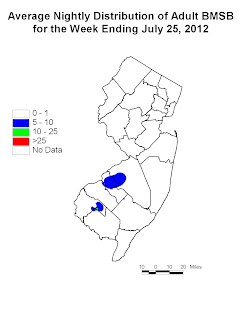Anne Nielson, PhD, Assistant Extension Specialist in Fruit Entomology, Win Cowgill, Professor and County Agricultural Agent
We are researching the best monitoring methods for BMSB in a variety of crops.
Dr. George Hamilton, Rutgers maintains a series of Black Light Traps throughout NJ along with Kris Holmstrom, Rutgers Vegetable IPM. They check these traps weekly and publish a BMSB map in the weekly plant and pest vegetable newsletter. All maps are also archived at the Rutgers Vegetable IPM website.
Note that the archive is a few weeks behind but should be caught up by the end of this week. You can also down load back issues of the Vegetable Plant and Pest to view the map for those weeks.
We are researching the best monitoring methods for BMSB in a variety of crops.
Visual or beat/shake sampling in crops can be a good way to scout for BMSB but is a nocturnal insect with very good hiding behaviors. This can make it very difficult to detect populations in the field.
At the current time, blacklight traps give us the best indication of activity and relative numbers. The numbers in NJ blacklight traps have increased substantially over the past few weeks. In general the numbers are much lower than previous years but they do indicate that populations have increased.
There is stink bug pressure in many orchards and we are still finding egg masses and young nymphs as well as adults, however the numbers are significantly less than 2010. Please see the Rutgers IPM website for average nightly trap captures in your area.
Note: the map files are in format. It is very interesting to have several weeks of maps open at a time to compare the trends in your area. They are giving an average nightly catch so you times by 7 to get the weekly.
http://www.pestmanagement.rutgers.edu/IPM/Vegetable/Pest%20Maps/maparchive.htm
Rutgers Snyder Farm went from total weekly catches of: 10-20-40-114,
and this week the numbers dropped back to 85 for the week, which is reflected
in the map. Thus, the blacklight traps in combination with visual samples and damage assessments of fruit indicate that the population is quite active, feeding and reproducing in many crops.
Please maintain coverage.
For detailed information please see deans notes in this weeks Rutgers Tree Fruit Plant and Pest newsletter for the best materials to use and PHI’s. He recommends alternate middle sprays 5-7 days apart.



